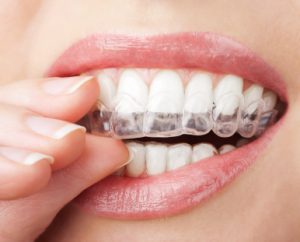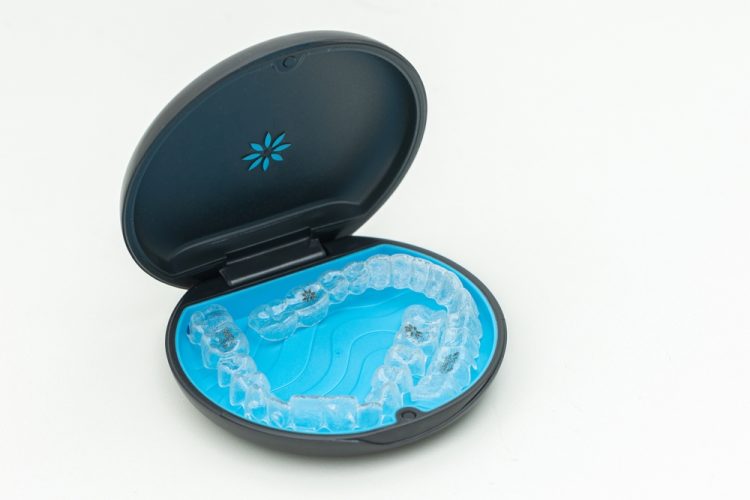Invisalign Braces – The Virtually Invisible Way to Straighten Your Teeth
by Dr. Carole Sherrod Jewell, DMD, Red Bank, New Jersey
Invisalign® is a faster and more affordable way to straighten your teeth than traditional metal braces. Invisalign® Braces are the virtually invisible way to get a straight smile without the “metal mouth.” Patients also enjoy the cosmetic benefit of clear aligners along with the flexibility that comes from being able to remove the Invisalign® aligning trays for important occasions, or when you brush your teeth, eat, or drink. Check out our Invisalign Special.
Dr. Carole Sherrod Jewell DMD is a general dentist who has completed specialized instructional sessions in order to become an “Invisalign® Braces” provider in Red Bank, New Jersey. She is trained to create customized Invisalign® treatment plans for the patients who qualify for this low-maintenance teeth-straightening option.
How does Invisalign® work and what is the Invisalign® treatment process?
Once Dr. Sherrod Jewel has determined that you are a good candidate for Invisalign®, she will create an initial treatment plan which will then be displayed as a 3-dimensional picture of your mouth that can be seen on the computer screen. Dr. Sherrod Jewell can then move the teeth around on the screen and observe the jaw from different angles to see potential treatment results.
After devising a plan, a unique set of aligners is developed. You will progress through a series of custom-developed aligning trays that will be worn for approximately 2 weeks and then changed out for the next tray in order to gradually move your teeth into their proper alignment.
Here are some important facts to know about Invisalign® treatment:
- In many cases, Invisalign® can take half the time of traditional metal braces to straighten teeth. Invisalign® treatment is completed in about nine to 15 months with an average of about 12 months.
- The total length of your Invisalign® treatment, however, depends on a number of factors, including how quickly your teeth shift and your dedication to your orthodontic treatment. If you are diligent about wearing your aligners as laid out by your dentist in your customized treatment plan, your treatment is more likely to progress as anticipated.
- You will be expected to visit your dentist every six weeks or so to make sure your Invisalign® treatment is advancing properly and to receive new sets of aligners to maintain your straightening. Invisalign® eliminates the need to visit your orthodontist every few weeks for bracket and wire tightening or repairs like traditional braces-wearers must do.
- Each new set of Invisalign® aligners is worn for about two weeks, sometimes longer. This timeline will vary depending on the treatment plan Dr. Sherrod Jewell has laid out for you. Aligners are designed to move certain teeth at certain times, not all of your teeth at once. Invisalign® is designed to be a consistent and gentler orthodontic treatment, so your dentist may advise wearing some aligners for lengthier periods of time.
- Your Invisalign® aligners should only be removed four to six times a day – for eating, brushing, and flossing – so that you are able to meet the minimum requirement of wearing the aligners for 20-22 hours every day.
- The average Invisalign® wearer will have between 18 and 30 aligners throughout the course of their Invisalign® treatment. This number will vary depending on where your teeth are now and where they need to move. Dr. Sherrod Jewell will determine this aligner number at the beginning of your customized treatment.
How do I take care of my Invisalign® aligners?

Traditional braces are complicated and intricate, which means the accompanying brushing and flossing techniques need to be just as detailed and meticulous. Cleaning metal braces requires time and patience multiple times a day in order to make sure that every crevice is properly cleaned to avoid staining, breakage, or discomfort. Wearers of traditional braces must be extremely diligent about the maintenance of their orthodontia.
Invisalign® wearers don’t have the same concerns because they can easily pop out their aligners to brush and floss, then put their aligner right back in place. Cleaning, nevertheless, is still an important element of wearing Invisalign® so that your aligners do not develop an odor, discoloration, or a buildup of bacteria.
Dos and don’ts of caring for Invisalign® aligners:
- Do rinse your aligners every time your remove them and before you put them back in your mouth in order to wash away dried saliva and plaque and ward off the build-up of bacteria.
- Do soak your aligners regularly according to your dentist’s recommended cleaning solution or the official Invisalign® cleaning crystals so the trays stay sanitized and clear.
- Don’t use toothpaste to clean your aligners. Whitening toothpastes in particular are abrasive and can damage or dull your Invisalign® trays.
- Do brush your aligners, but make sure it’s done gently so that you don’t scratch the trays.
- Don’t eat or drink anything but water while wearing Invisalign® so that you avoid staining your aligners.
- Do brush and floss before putting your Invisalign® aligners back in your mouth in order to maintain good oral hygiene and avoid cavities and decay. Invisalign® is a form-fitted treatment and failing to care for your teeth properly can trap bacteria between your aligners and teeth.
What issues does Invisalign® correct?
Invisalign® or traditional metal braces can be used to treat similar dental issues. The difference is that Invisalign® trays look almost invisible and can be removed when necessary. Some of the problems that are commonly corrected with Invisalign® include:
- Overbite: This problem occurs when there is an overlap between the upper teeth and the lower teeth. In some cases, jaw pain and TMJ can be a result.
- Underbite: This is the opposite of an overbite and occurs when the lower teeth overlap with the upper teeth. In some cases, jaw pain and TMJ can be a result.
- Overcrowding: When there isn’t enough room in the mouth for all of the teeth to be in normal alignment, this can occur. It can lead to tooth decay and gum disease.
- Crossbite: This occurs when the bite meets unevenly. It can lead to uneven wear, bone erosion and gum disease.
- Large gaps: If the jaw grows abnormally or there are missing teeth in the mouth, large gaps can occur.
What does it feel like to wear Invisalign®?
Just like traditional braces-wearers, any soon-to-be Invisalign® wearer naturally wants to know what it’s going to feel like to have those aligners on your teeth all day long. As with any orthodontic treatment, wearing the trays will require a slight adjustment period. While there may be temporary discomfort for a few days at the beginning of each new stage of treatment, this feeling of pressure means the aligners are doing their job and shifting your teeth as intended.
What you will avoid with Invisalign® is the kind of damage or irritation that metal braces often inflict, like cuts or jabs on the cheeks, lips, and gums because of sharp brackets or wires.
What will I look like while wearing Invisalign®?
One of the main reasons adults shy away from orthodontic treatment is because they are embarrassed at the thought of looking like a teenager with metal mouth. Invisalign® has changed that reality. The clear aligners really are nearly invisible. Unless you tell someone that you’re wearing Invisalign®, they’re unlikely to notice just from a simple interaction with you. The aligners are made from a thin, clear, durable, plastic material and have been designed to be aesthetically pleasing. They won’t change your appearance at all other than to gradually shift your teeth into their proper alignment and give you a stunning straight smile.
What is an Invisalign® attachment?
Not every Invisalign® wearer will need attachments, which are sometimes referred to as ridges. Depending on your specific treatment plan, some of the movements may require you to have small attachments made of tooth-colored composites put on your teeth. These attachments are gripped onto by the bumps in your aligners so that your teeth achieve the desired tooth movement.
What are the benefits of wearing Invisalign®?
The benefits of Invisalign® are many.
- Invisalign® is virtually invisible and allows you to straighten your teeth without announcing your orthodontic treatment to the world.
- The Invisalign® aligners are removable for mealtimes and snacks, enabling you to eat and drink whatever you want without worrying about foods getting stuck in or damaging your braces.
- Brush and floss as normal. There is no need to acquire special tools to clean your teeth. Invisalign® braces let you maintain your normal brushing and flossing habits with no need to meticulously clean around wires and brackets.
- Invisalign® requires fewer visits to the dentist and straightens crooked teeth in less time than traditional metal braces.
But besides these significant features, there are other benefits of Invisalign® that you may not have even considered and that will positively impact your health and lifestyle.
Invisalign® will:
- Improve your oral health. When your teeth are straight, they are easier to clean thoroughly which means you’ll have healthier teeth and gums and reduce your risk of developing cavities or gum disease.
- Give you better digestion. If your teeth aren’t straight, your digestive system has to work much harder to break down the food you eat into manageable pieces. When your teeth are aligned, they minimize the chances of developing ulcer, indigestion, or other problems that can come from an overworked digestive system. Plus, being able to remove your aligners to eat means you’ll have no problem keeping up with a balanced diet while undergoing Invisalign® treatment, unlike metal braces-wearers who are restricted in some of the foods they can eat.
- Improve your speech. When your teeth are straight and your jaw is in proper alignment, you’ll be able to achieve clear speech. The teeth, tongue, and palette have to work together to help you speak or sing. When teeth are misaligned, your tongue will encounter greater difficulties forming words. Invisalign® is hardly noticeable and very comfortable and, once your mouth is used to the sensation of the aligners, your speech will not be compromised – it can only get better.
- Boost your confidence. When you’re proud of how you look, your confidence goes up. Knowing that your smile is straight and impressive will make you proud to flash a grin, eat with others, and speak freely. Plus, being confident in your own appearance will be noticeable to others, and that kind of belief in yourself can give a great boost to you both personally and professionally. Your quality of life will improve – Invisalign® can be life-changing.
Is there anything I should consider before deciding upon Invisalign® treatment?
 Any orthodontic treatment requires an adjustment period. It may take some time for you to become used to the Invisalign® aligning trays. They must be worn all the time, except during meals when food can become trapped inside.
Any orthodontic treatment requires an adjustment period. It may take some time for you to become used to the Invisalign® aligning trays. They must be worn all the time, except during meals when food can become trapped inside.
Be aware that, after your Invisalign® treatment is complete, most dentists will recommend that you wear a retainer to prevent your teeth from shifting back to their previous position. Depending on your orthodontic treatment, you may only need a retainer for either your upper or your lower teeth, and you may not need to wear it all the time. Every case is different.
Some adults who have had braces in the past are now dealing with teeth that have shifted. In cases like this, Invisalign® can often be used to correct the problem. In other words, there may be no need to undergo the social trauma and awkwardness of wearing metal braces once again.
Many people have concerns about dental braces and the effect that metalwork could have on their smile. Adults are especially sensitive to the appearance of metal braces. Invisalign® braces straighten your teeth quickly without the use of metal and are practically invisible. And even though Invisalign® is worn for the majority of every day, it doesn’t interfere with your daily life. The aligners are barely noticeable, which allows you to go about your normal routine without concerns about your orthodontia.
You’ll never know if you’re a good candidate for Invisalign® unless you talk to your dentist about it. Ask Dr. Sherrod Jewell all of your orthodontia questions and find out whether Invisalign® treatment is right for you.




